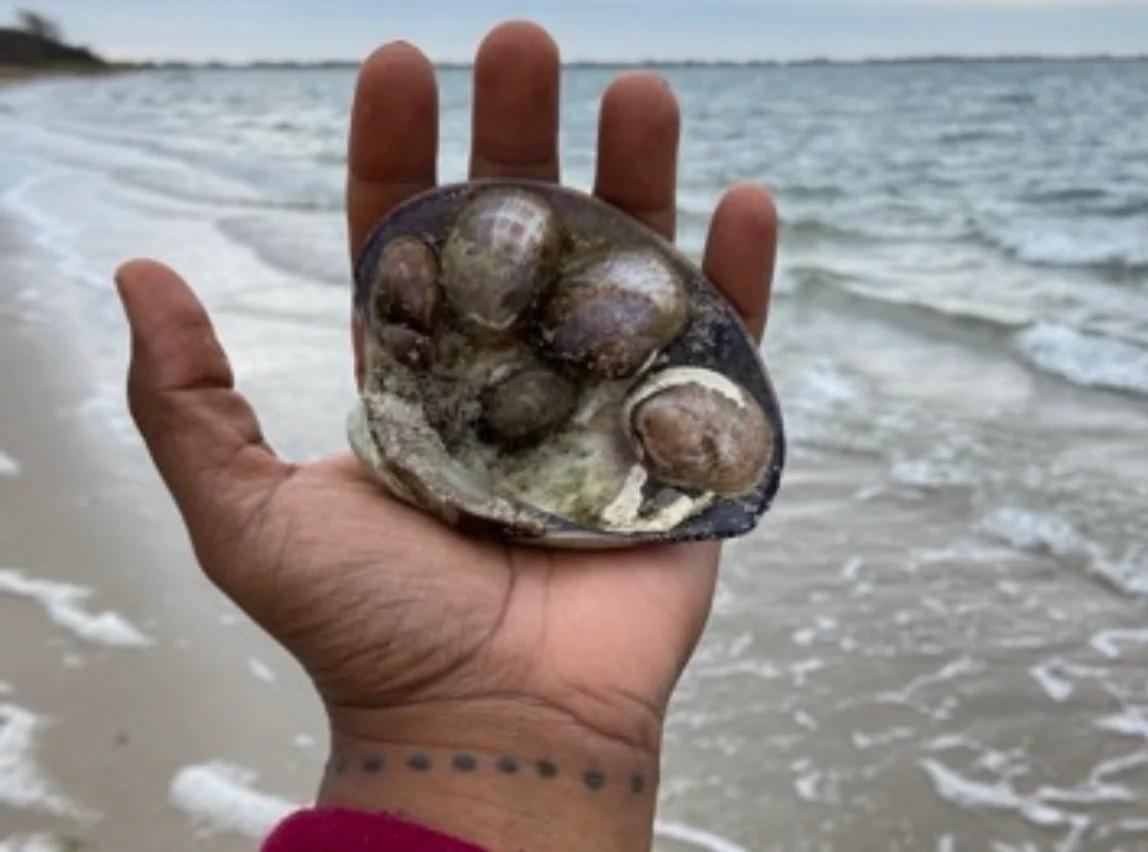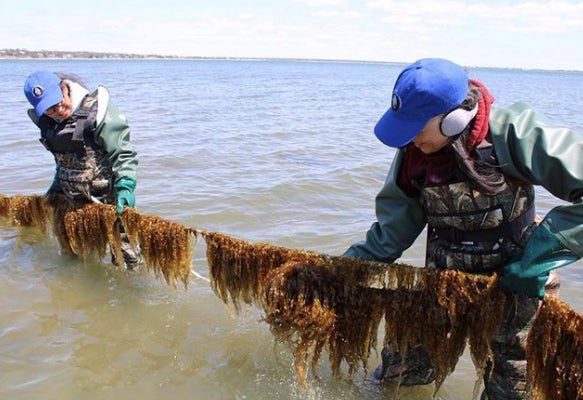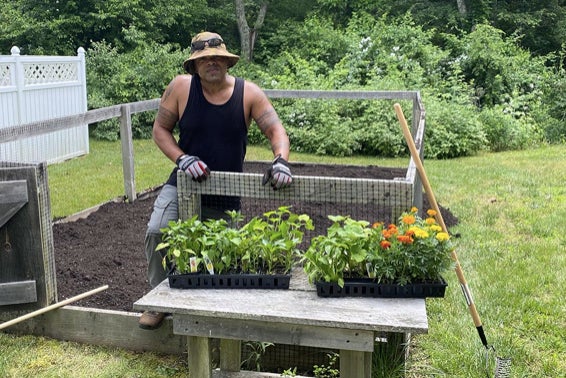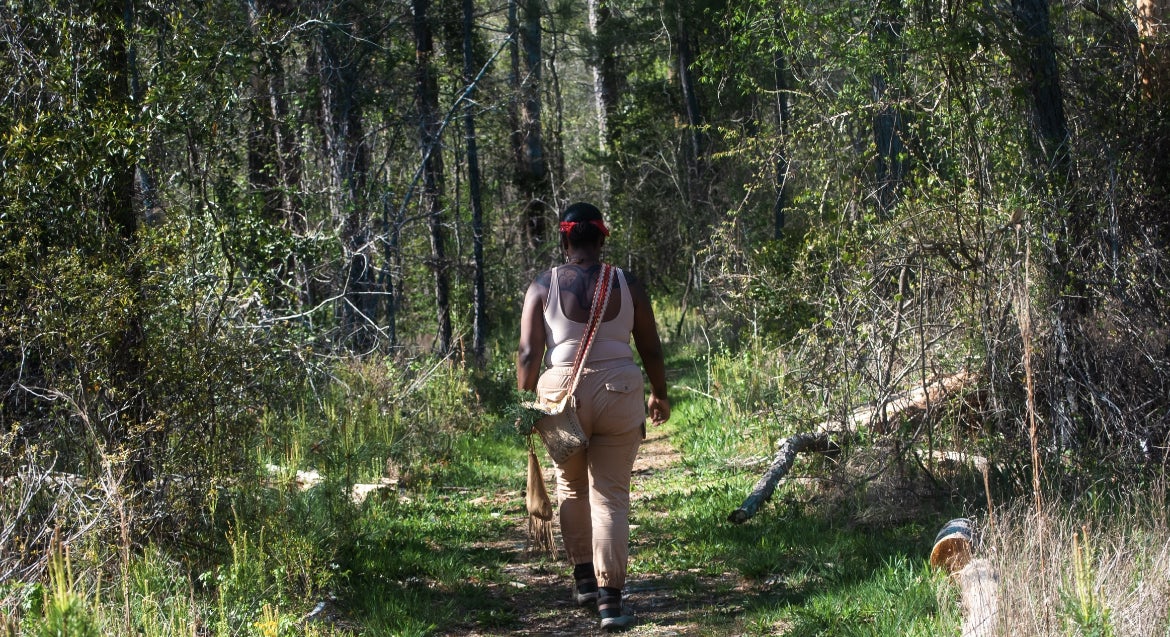
By Chenae Bullock (Shinnecock)
When I think about climate disasters—the floods, the storms, the fires—I don’t just see headlines. I see faces. I see the coastline of the Northeastern seaboard, where our Tribal communities watch the sea inch closer each year. I think about how saltwater creeps into our wells, how the marshlands that once fed generations of shellfish gatherers are slowly disappearing beneath the tides. And I think about how we are not waiting for help to come: we are already adapting, already teaching the world what true resilience looks like. We often talk about “disaster relief” as though the world can be neatly rebuilt after it breaks. But for Indigenous communities, relief isn’t a project that begins after the storm. It’s a relationship, one that starts long before disaster and continues long after. It’s a way of living that listens to the land, honors the water, and understands that healing means restoring balance, not control.
Learning from the Land and Those Who Listen to It
Many people grow up believing that knowledge lives in books and institutions. But every time I sit with a keeper of our ancient knowledge, I’m reminded that the land itself is our oldest textbook. Every tide, every season, every migration tells a story, if we are willing to listen.
The Passamaquoddy, who live on the northeastern tip of Maine, embody this truth. They’ve built what they call a “resilience basket,” an idea drawn from their basket-making traditions. Each strand represents a part of what sustains life: food security, clean water, housing, culture, and energy. The basket reminds them, and all of us, that survival is never just physical; it’s cultural, spiritual, and deeply relational. When saltwater began overtaking their clam beds, they didn’t wait for outside engineers. Instead, they revived ancient clam gardens—shallow rock terraces that help shellfish grow while softening the force of the tides. They replanted native berry bushes to stabilize the soil and revived solar-powered systems so that when storms knock out the grid, their homes still have light. This isn’t simply adaptation. It's the continuation of the ongoing story of a People who have always lived by the sea, and are still listening to it today.

Shinnecock Kelp Farmers Donna Collin-Smith, right, and Danielle Hopson Begun check a line of kelp being grown in Shinnecock Bay on Eastern Long Island. Photo by Chris Berlinger.
Holding Ground on Long Island
Further down the Atlantic coastline, my own community, the Shinnecock Nation on eastern Long Island, faces a different, but familiar, struggle. Our land grows smaller each year as the tides rise, threatening our burial grounds, our homes, and our sacred sites. I remember standing at the edge of the beach, where the wind never stops, feeling how deeply we belong to that place. We can’t talk about relocation or “managed retreat” without hearing the grief in our voices. Moving isn’t just losing land: it’s losing stories, songs, and ancestors.
To guide our adaptation work, we’ve turned to a framework created by Shinnecock citizen Dr. Kelsey Leonard, an environmental scientist and advocate who developed the WAMPUM model, an Indigenous-designed approach to sea level rise adaptation. Named after the wampum bead, small but powerful in meaning, the framework stands for Witness, Acknowledge, Mend, Protect, Unite, Move. Each word is both action and prayer:
- Witness the changes and truths before us
- Acknowledge the harm both ecological and historical that has led to our vulnerability
- Mend the relationships among people, land, and water
- Protect what remains: our shorelines, burial sites, and ecosystems
- Unite our community in shared responsibility
- Move forward, not away from the land, but with it
At Shinnecock, this philosophy has inspired tangible work. We are restoring oyster reefs and planting beach grass to strengthen our natural barriers. We’re studying coastal hydrology while honoring our traditional shell fishing knowledge. We’re holding community gatherings where cultural stewards teach about water sovereignty, traditional foodways, and sustainable harvesting: lessons that guide how we respond to flooding and erosion. The WAMPUM model isn’t just for Shinnecock or Indigenous Nations. It offers a blueprint for all coastal communities—a reminder that adaptation begins with honesty, care, and cooperation. When we combine Traditional Ecological Knowledge with modern science, we don’t just fight against rising seas; we learn how to rise with them.
In early 2022, the Institute for Ocean Conservation Science, in partnership with The Explorers Club, nominated Shinnecock Bay as a Mission Blue Hope Spot, the first in New York State and one of only a few on the entire East Coast. Hope Spots are special places in the ocean identified by marine scientists, Indigenous communities, and conservationists as critical to the health of the planet’s blue ecosystems. They are regions where local protection and restoration efforts can have a global impact, helping to rebuild marine biodiversity and strengthen climate resilience.
For the Shinnecock Nation, this recognition was deeply meaningful. It affirmed what our people have always known: that Shinnecock Bay is not just water, but a living relative, a source of food, identity, and spiritual connection that has sustained us for thousands of years. What makes the Shinnecock Hope Spot truly historic is that Leonard, along with a group of fellow Shinnecock citizens, formed the first-ever Indigenous Advisory Council for a Hope Spot anywhere in the world. This council ensures that Indigenous leadership and Traditional Ecological Knowledge guide how the bay is studied, restored, and protected.
The Indigenous Advisory Council serves as a bridge between western science and Indigenous stewardship. Its members advise on habitat restoration, water quality monitoring, and sustainable fisheries management while grounding each effort in Shinnecock values of reciprocity and respect for the ocean. The council also works to build partnerships between Tribal citizens, scientists, and conservation organizations, ensuring that decisions about the bay reflect the voices of those who have lived in relationship with it since time immemorial. By embedding Indigenous governance within the Hope Spot model, Shinnecock is reshaping what marine conservation looks like, transforming it from a science-driven initiative into a living collaboration rooted in cultural sovereignty, ancestral knowledge, and care for future generations.

Rocky Johnson (Narragansett) leads the Indigenous Roots Forever Program. Photo by Chenae Bullock.
Education as Cultural Continuity
Our resilience also grows through the educational workshops led by cultural stewards across Tribal communities. These workshops bring us back to traditional lifeways, from coastal planting and controlled burning to food preservation, canoe building, and ceremony, showing how these practices are vital to modern disaster preparedness and recovery. When young people learn to harvest shellfish sustainably or to read the tides, they aren’t just learning skills; they are inheriting the knowledge of survival. When they learn about building homes from natural, locally available materials, they’re learning how to withstand storms. When they listen to the stories of how our ancestors survived earlier floods, droughts, or displacements, they see that our strength lies not in control but in relationship. These teachings, passed down through workshops and community gatherings, keep our traditions alive while preparing us for the challenges ahead. Cultural education is disaster relief, not in the sense of emergency response, but in the deeper sense of building communities that can withstand and recover together.
Relief as Relationship
So much of today’s climate response feels mechanical—a matter of logistics, funding, and infrastructure. But Indigenous Peoples remind us that real relief begins with relationships: to the land, to our ancestors, to one another. Here in the Northeast, that truth runs deep. The forests, rivers, and coastlines have always been shared by teachers for the Wampanoag, the Nipmuc, the Penobscot, the Unkechaug, the Mi’kmaq, the Narragansett, and so many others. Our teachings show that resilience isn’t something built from the outside; it's something remembered from within. And that remembering asks for humility. It asks governments and NGOs to stop treating Indigenous knowledge as supplemental and to recognize it as essential. It asks all of us to listen more and impose less. Communities that have survived centuries of colonization already know what endurance looks like, not because we chose hardship, but because we learned how to keep life going when systems failed us.

Top photo: Chenae Walking through an old-growth forest in Georgia. Photo by Gabriel Rudd.
What the Land Keeps Teaching
When a storm tears through, western relief agencies often rush to rebuild what was lost. But the land doesn’t rebuild; it transforms. And Indigenous knowledge teaches us to transform with it—to plant differently, build differently, relate differently. When I visit communities like ours, I see people who are not waiting to be saved. They are saving themselves and showing the rest of us what true reciprocity looks like, even amid disaster. So, when I think about the future of climate relief, I think about that Passamaquoddy basket: strong because of many strands woven together. Relief that isn’t just technical, but cultural. Not just reactive but rooted. Not just survival, but the continuation of life in all its forms. Because in the end, resilience isn’t about bouncing back. It’s about belonging again to each other, and to the Earth, that against all odds, keeps teaching us how to heal.
—Chenae Bullock is an enrolled Shinnecock Indian Nation Tribal member and descendant of the Montauk Tribe in Long Island, New York. She is a community leader, water protector, cultural preservationist, Indigenous perspective historian, and humanitarian. She is also the founder and CEO of Moskehtu Consulting, LLC.
Top photo: Quahog shell as an ecosystem for other shells on the Shinnecock shoreline. Photo by Chenae Bullock.



